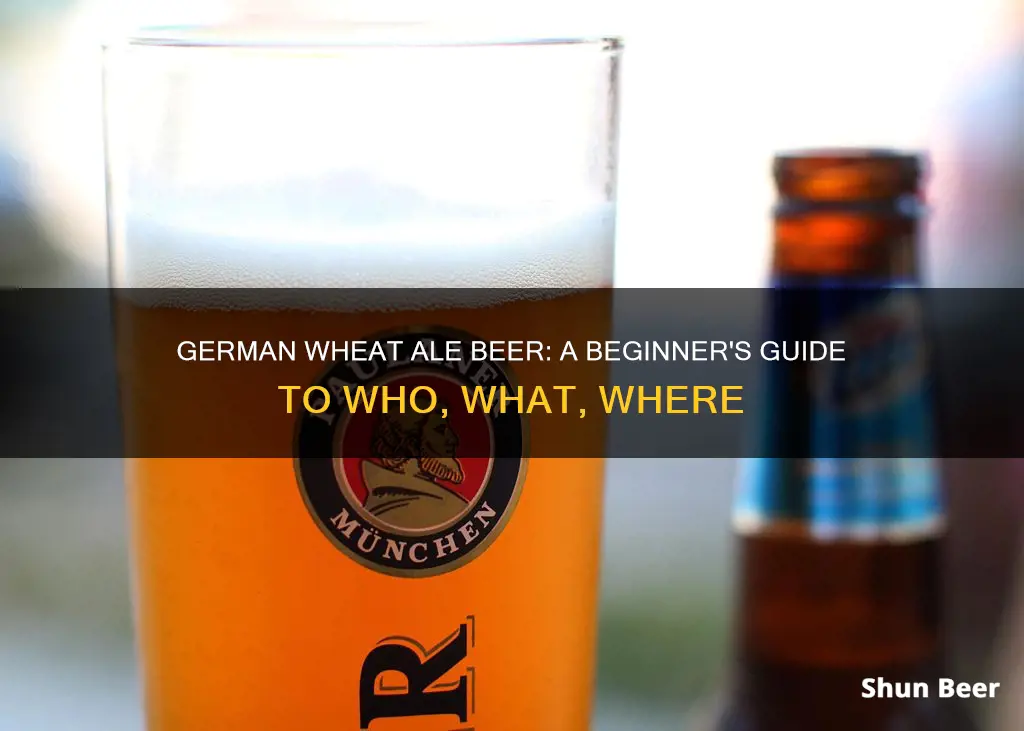
Wheat beer, also known as Weizenbier, is a top-fermented beer that originated in Germany and has been brewed since the Middle Ages. It is made with a large proportion of wheat relative to the amount of malted barley, resulting in a fluffy, tangy, pale ale with a unique flavour. German wheat beer is known for its banana and clove flavours, produced by the yeast, and is often served in a tall, curvaceous glass known as a weizen vase.
| Characteristics | Values |
|---|---|
| Country of Origin | Germany |
| Main Variety | Weizenbier |
| Other Types | Berliner Weisse, Gose, Lambic |
| Appearance | Cloudy, Golden |
| Flavour | Banana, Clove, Bubblegum, Black Pepper |
| Alcohol Content | Low to Moderate |
| Bitterness | Low |
| Carbonation | High |
| Serving Glass | Weizen Vase |

German Weizenbier
The German-style Hefeweizen is straw to amber in colour and brewed with at least 50% malted wheat. The aroma and flavour of a Weizenbier come largely from the yeast and are fruity (banana) and phenolic (clove). The intensity of these flavour qualities varies depending on the brewer, but the two are most commonly balanced. Hefeweizen typically contains a low to moderate alcohol content and is considered the most popular among the German Weizenbier variety.
The German word "hefe" refers to the yeast that remains in suspension, giving the beer its cloudy appearance, and "weizen" denotes the use of wheat. This wheat beer is best served in a large, curvaceous glass, known as a Weizen vase, which showcases the beer's beautiful glow and large, persistent foam cap.
Beasley Beer: Wheat or Not Wheat?
You may want to see also

Belgian witbier
The style of witbier dates back to the 16th and 17th centuries, when the white beers of Hoegaarden and Leuven in Flemish Brabant, Belgium, first gained renown. The original recipes included barley malt, unmalted barley, and oats, with the barley dried in the wind on rooftops to achieve a lighter colour. The style fell into obscurity until it was revived by Belgian brewer Pierre Celis in the 1960s, who is also credited with adding coriander and orange peels to the recipe.
Today, Belgian witbiers typically have an ABV of 4.5 to 5.5%, although this can range from 4.0 to 7.0% in some cases. The optimal glassware for serving witbier is a tall Weizen glass, which accommodates the beer's large, frothy head and showcases its unique aroma. Witbiers are best paired with lighter foods such as salads, cheese, fish, and seafood.
Yeungling Beer: Wheat or Not?
You may want to see also

German Weißbier
Weißbier is often referred to as Hefeweizen, especially in the southern parts of its origin region, Bavaria. "Hefe" refers to the yeast that remains in suspension, giving the beer its cloudy appearance, while "weizen" denotes the use of wheat. This style of beer is characterised by its unique flavours, which are largely derived from the yeast and can include banana, clove, bubblegum, and even vanilla. The yeast also contributes to the beer's high carbonation level, resulting in lively bubbles.
The appearance of German Weißbier is just as important as its flavour. It is traditionally served in a large, curvaceous glass called a "weizen vase", which showcases the beer's beautiful glow and its large, persistent foam head. This foam is a result of the high protein content of wheat malt.
Weißbier has a long and interesting history in Germany, dating back to the 12th or 13th century in Bohemia (now the Czech Republic). In the 16th century, wheat beer brewing became a monopoly of the ruling Wittelsbach dynasty of Bavaria, who granted the noble Degenberg family the exclusive right to brew wheat beer. Over time, the monopoly passed through various hands, and by the 19th century, Bavarian lagers began to gain in popularity over Weißbier. However, in the 1960s, there was a sudden revival in the popularity of Weißbier, both in Bavaria and worldwide, and it has since become the most popular beer style in the region.
Grain Belt Beer: Wheat or Not?
You may want to see also

German Weizenbock
There are both pale and dark versions of the Weizenbock style. The dark versions will be somewhere between a dark amber and a dusky reddish-brown, while the pale version should fall somewhere between a sun-touched golden and a honeyed amber. The style should have a thick, almost moussy, and very long-lasting head.
Head on pale versions are white to slightly off-white, while the darker versions should carry a light tan head. This is a traditionally unfiltered style so cloudiness is expected, especially with the high protein content of wheat and possible suspension of yeast sediment.
The yeast, malt, and alcohol all play a role in creating a prominent and inviting aroma. Malt character will be moderately high to high, rich, and have an enticing wheat tone of bready grain. Pale versions will have a rich malt complexity of bready toastiness, with just light toasting. Darker versions will have a deeper richness to the malt with Maillard reactions prominent.
The combination of rich malt, alcohol, and yeast often creates subtle complexities that age well. There should be no hop flavour, though low hop bitterness can, especially in the higher-gravity examples, make sweetness more noticeable. However, most good examples finish dry; the dry finish often being heightened by subtle notes of alcohol.
Exploring Bock and Wheat Beer Differences
You may want to see also

German Hefeweizen
Hefeweizen is considered one of the most popular beers in the world and has survived hard times throughout its history. The style originated in the breweries of Bavaria, Germany, in the 1520s. At the time, German regulations did not allow it to flourish due to the Reinheitsgebot or Purity Law, which stated that the only allowable ingredients in making beer were barley, hops, and water. However, the rulers of Bavaria, the Dukes of Wittelsbach, created a loophole called the "right to brew wheat beer", allowing a single brewery in the village of Schwarzach to brew weizenbier.
Hefeweizen is a delight for the senses. It has a bready flavour with a soft, pillowy mouthfeel and a medium-full body. The beer is served unfiltered with plenty of yeast in suspension, creating a thick, fluffy head. The aroma of a German Hefeweizen is fruity and phenolic, with notes of banana, clove, bubblegum, and even black pepper.
Hefeweizen is an easy-drinking, refreshing beer that is perfect for a hot summer day or a cosy night by the fire pit in the fall. It is best served cold in a specific style of glass called a Weizenbier glass, which is shaped like a modified tulip to form the desired white head when the beer is poured.
Blue Moon Beer: Wheat or Not?
You may want to see also
Frequently asked questions
German Wheat Ale Beer, or Weizenbier and Weißbier in German, is a top-fermented beer brewed with a large proportion of wheat relative to the amount of malted barley.
The two main varieties are German Weizenbier and Belgian witbier. Other types include Lambic (made with wild yeast), Berliner Weisse (a cloudy, sour beer), and Gose (a sour, salty beer).
The four largest brands in Germany are Erdinger, Paulaner, Franziskaner, and Maisel.
German Wheat Ale Beer is typically fruity (banana) and phenolic (clove).







